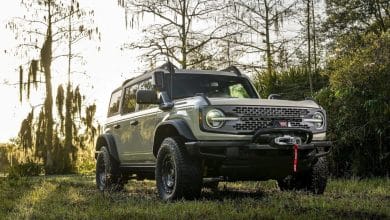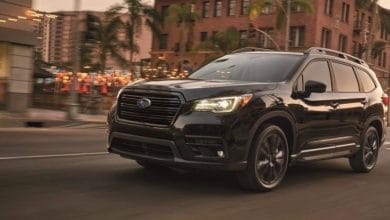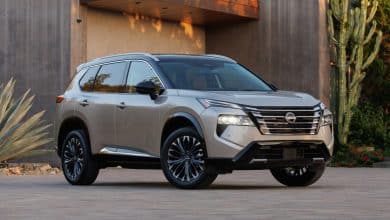The Mustang is the tail of a comet which is finally burning up. Appearing in the 1960s, the Mustang offered the rising generation a financially accessible vehicle with a sporty look. Thus was born the era of pony cars, a category of which the Mustang will probably be the last representative. A chapter that closes. One again.
In a few months, the Mustang will find itself alone. The Challenger and Camaro, its natural rivals, will then have thrown in the towel. The Mustang? She intends to resist for a while longer. The day the ban on the sale of an internal combustion vehicle comes into force, she will have to resign herself to joining collectors’ gatherings. This therefore leaves us another 11 years to appreciate this model deeply rooted in American culture.
Lots of memories come to mind when you look at a Ford Mustang, which has had its ups and downs. We will not blame its (many) faithful for retaining only the best of this story. It began on April 17, 1964 at the New York World’s Fair (see the “Technical Sheet” tab), where some 22,000 consumers placed orders to obtain one. The Ford Motor Company expected annual sales of 80,000 units in its first year; it sold nearly 420,000.
-

PHOTO PROVIDED BY FORD
At the wheel of this car, there are good and bad things, including with the V8. When started, this big V8 emits a sort of muffled rumble, which is in no way unpleasant.
-

PHOTO PROVIDED BY FORD
The Mustang’s behavior on dry roads and in good condition deserves to be described as healthy.
-

PHOTO PROVIDED BY FORD
Carefully redesigned, the Mustang is longer and taller than the previous model.
-

PHOTO PROVIDED BY FORD
The rims of the Ford Mustang
-

PHOTO PROVIDED BY FORD
To add to the happiness, a six-speed manual transmission takes care of transmitting all the power to the rear wheels.
-

PHOTO PROVIDED BY FORD
The dashboard of the Ford Mustang
-

PHOTO PROVIDED BY FORD
Ford Mustang seats
1/7
An evolution, not a revolution
The Mustang revealed a year ago at the Detroit Motor Show presents itself as the seventh generation. To convince us, it even has a different code (S650) from its predecessor (S550). However, apart from new plastic, a redesigned interior and some developments (chassis and mechanics), it would be more accurate to see it as an evolution of the previous model. His followers do not take offense, only too happy that the ax of the guillotine has still not reached their favorite model.
At the wheel of this car, there are good and bad things, including with the V8. When started, this big V8 emits a sort of muffled rumble, which is in no way unpleasant.
At low and medium speeds, this Mustang cannot be described as silent. On the other hand, it is expressive. Acceleration and pickup are solid. The 5 L, which now provides a brisk 480 hp and 415 lb-ft of torque, as long as you fill it with premium gasoline, catapults you out of tight turns with disconcerting ease.
And to add to the happiness, a six-speed manual transmission takes care of transmitting all the power to the rear wheels. Despite its robust control and equally robust clutch pedal, it remains the transmission of choice compared to the automatic, which lacks responsiveness and costs an additional $1,750. Speaking of optional equipment, unless you’re an enthusiast or intend to take part in a racetrack, the performance options offered are neither worth the detour nor the asking price.
The Mustang’s behavior on dry roads and in good condition deserves to be described as healthy. The more rigid chassis and revised suspension elements allow you to travel on board without urgently requiring the services of a chiropractor once at your destination. It’s firm, yes, but how could it be otherwise? Moreover, this is not the only constraint linked to this sports car. Just slipping in or out of your seat will be real torture for some. This will certainly be the case for those who are invited to ride in the back, as space is so limited.
The grip on the road is reminiscent of Velcro. Despite a faster gear ratio, the steering feel still lacks naturalness and does not instantly create confidence. The settings offered (lightening or heavier steering) are not entirely satisfactory either. The formerly very oversteering nature (rear that stalls) of this vehicle has been considerably calmed down with the help of (too many) electronic crutches. Apart from limiting ground clearance, winter use is not completely excluded with good quality winter tires.
In need of nostalgia
Carefully redesigned, the Mustang is longer and taller than the previous model. Its wheelbase has been reduced, but no one will notice it as much as the interior presentation. We can easily understand that the Mustang cannot ignore trends, but was it really necessary to make the infotainment screen such a catch-all? As intuitive as it is, this interface appears so artificial in such a vehicle. Since this line is coming to an end, why not bring a breath of nostalgia on board with real counters? Even if it is not the most inspired, the interior presentation has the merit of being (just a little) more rewarding than before (choice of better quality materials).
Those nostalgic (or die-hard?) for American sports driving will find comfort behind the wheel of this car which is responsible for making us experience these sensations that the vehicle of tomorrow will never again provide.
Ford Mustang
Trial variation
5.0
Price range
From $37,000 to $79,365
Consumption
9.2 L/100 km (2.3 Ecoboost), 9.8 L/100 km (5.0), 13.1 L/100 km (Dark Horse)
WE love
- That it still exists
- May the manual transmission resist extinction too
- That the asking price remains realistic
We like less
- That the infotainment center swallows almost everything
- That management filters sensations too much
- That the catalog of options is also stocked
Our Verdict
Today is now. Tomorrow, it will be too late !
Share your experience
The Press will soon publish the test of the following vehicles: Cadillac Lyriq, GMC Sierra, Lucid Air, Rivian R1S, Tesla Model Y, Toyota Tacoma and Volkswagen Atlas. If you own one of these vehicles or are awaiting delivery, we would love to hear from you.












